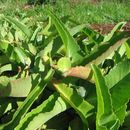Brief Summary
provided by IABIN
Diagnosis A species of the genus Oreobatescharacterized by (1) head wider than long, snout long, subacuminate in dorsal and lateral views, canthus rostralis straight in dorsal view, rounded in profile; (2) tympanic membrane and annulus distinct, tympanum length half of the eye length; supratympanic fold present; (3) cranial crests absent, upper eyelid with small tubercles; (4) dentigerous processes of vomers ovoid, prominent, posteromedial to choanae; (5) condition Â?SÂ? of adductor muscle (sensu Lynch 1986); (6) males with vocal slits and a single faint nonspinous nuptial pad on thumb; (7) terminal discs of fingers I and II rounded not enlarged, terminal discs of fingers III and IV truncated and enlarged, circumferential grooves incomplete, ungual flap poorly defined, terminal phalanges knob-shaped, lateral fringes and keels on fingers absent, ulnar tubercles absent, prominent subarticular tubercles, enlarged and conical in profile, supernumerary tubercles conical, smaller than subarticular tubercles; (8) first finger slightly longer than second; (9) toes long, lacking lateral fringes, webbing absent; fifth toe slightly shorter than third; (10) no tubercles on heel and tarsus, prominent subarticular tubercles, enlarged and conical in profile, inner metatarsal tubercle ovoid; (11) skin of dorsum scattered with soft tubercles, scapular and sacral glands present; (12) skin of venter smooth, discoidal fold present; (13) dorsal coloration of body and head in preservative brownish-gray with black marks; limbs brownish and striped with darker bands; venter whitish cream, throat finely mottled in gray.
- author
- José A. Langone
- editor
- Diego Arrieta
Distribution
provided by IABIN
Know only from three localities in the Province of Salta, Argentina.
- author
- José A. Langone
- editor
- Diego Arrieta
Diagnostic Description
provided by IABIN
Description of the holotype Adult male; snout-vent length 27.9 mm; head slightly wider than body, head length about 30% of snout-vent length, wider than long (head width/head length 1.1); snout subacuminate in dorsal view, and rounded in profile, tip of snout overlaps border of lower lip in lateral view, nostrils slightly protuberant, directed laterally; canthus rostralis straight in dorsal view, rounded in profile, loreal region slightly concave and moderately sloping; upper eyelid with small tubercles, eyes in lateral position, no cranial crests; supratympanic fold distinct, tympanic membrane and tympanic annulus distinct, tympanum nearly round, its length half of eye length, a large postrictal gland. Choanae rounded partially concealed by palatal shelf when roof of mouth is viewed from below; dentigerous process of vomers ovate, posteriormedial to choanae, about the size of a choanae, tongue subcircular, vocal slits present, posterolateral to tongue. Skin of dorsum scattered with soft tubercles, almost of the same size, with two larger glands on shoulders and two larger glands in sacral region surrounded by a kidney-shaped dark blotch; ventral surfaces smooth, dorsolateral folds composed by small warts, interrupted anteriorly; discoidal fold distinct. No ulnar tubercles; palmar tubercle moderately large, outer oval larger than inner rounded tubercle; subarticular tubercles single, conical, and prominent; supernumerary tubercles conical, smaller than subarticular tubercles; a single faint nonspinous nuptial pad on thumb; disc of fingers I and II rounded not enlarged, disc of fingers III and IV truncated and enlarged; fingers lacking lateral fringes and keels; relative length of fingers III>IV>I>II. Heel and tarsus lacking tubercles or folds; inner metatarsal tubercle ovoid, longer than wide; toes lacking lateral fringes and keels, webbing absent; fifth toe slightly shorter than third; terminal discs of toes I, II and V rounded not enlarged, discs of toes III and IV truncated and moderately enlarged; relative length of toes IV>III>V>II>I. Coloration: In life, dorsum bronze brown, marbled with dark brown, black and cream dots. Irregular interocular dark stripe; interscapular region with yellowish oval blotch. Iris golden, marbled with black; black supratympanic stripe; lips with diffuse brown and white perpendicular bars. A black irregular stripe departs from the tip of the snout and continues to the midpart of the flanks. Dorsal surfaces of forelimbs and hindlimbs with diffuse blackish and brown bars. Venter uniformly whitish, finely mottled with light brown. Throat mottled dark brown. In preservative, dorsal coloration of body and head brownish-gray with black marks; limbs brownish, stripped with darker bands; venter whitish cream, throat finely mottled in gray. Mean measurements (in mm) and proportions of holotype: snout-vent length 26.2; head length 8.7; head width 8.8; eye length 2.9; eye to nostril distance 4.3; internarial distance 2.2; eye-eye distance 4.8; tympanic membrane height 1.5; tympanic membrane length 1.4; arm length 6.0; thigh length 13.4; tibia length 12.6; foot length 13.7. Tibia length/snout-vent lengt 0.5; foot length/ snout-vent lengt 0.5; head length/ snout-vent lengt 0.3; head width/ snout-vent lengt 0.3; head width/head length 1.1; eye to nostril/eye length 1.7; tympanic membrane length/tympanic membrane height 0.9. Variation Range measurements (in mm) and proportions of male and female paratypes;: snout-vent length 21.2-29.9; 34.1; head length 7.6-10.5; 10.3; head width 7.7-10.1; 12.5; eye length 2.0-3.0; 3.1; eye to nostril distance 3.0-5.4; 4.8; internarial distance 1.9-2.4; 2.5; eye-eye distance 3.8-5.8; 6.2; tympanic membrane height 1.1-2.1; 2.0; tympanic membrane length 0.9-2.1; 2.0; arm length 4.7-7.0; 7.5; thigh length 10.5-15.8; 18.1; tibia length 10.5-14.5; 18.3; foot length 9.8-15.6; 16.6. Tibia length/ snout-vent lengt 0.4-0.5; 0.5; foot length/ snout-vent lengt 0.4-0.6; 0.5; head length/SVL 0.3-0.4; 0.5; head width/ snout-vent lengt 0.3-0.4; 0.3; head width/head length 0.9-1.2; 1.3; eye to nostril/eye length 1.5-2.0; 1.5; tympanic membrane length/tympanic membrane height 0.8-1.3; 0.9. Most noticeable morphological differences compared to the holotype are as follows: Skin of dorsum less warty to almost smooth; supratympanic fold less noticeable; upper eyelid with few small tubercles or smooth; discoidal fold less noticeable.
- author
- José A. Langone
- editor
- Diego Arrieta

